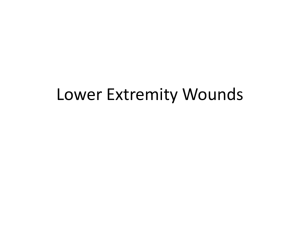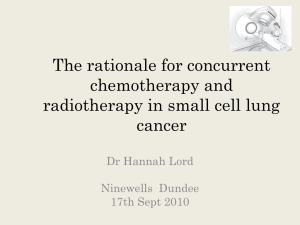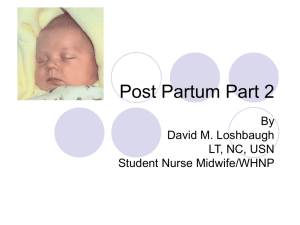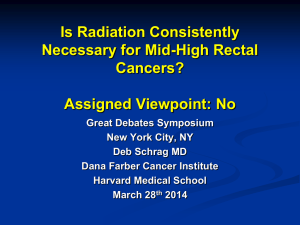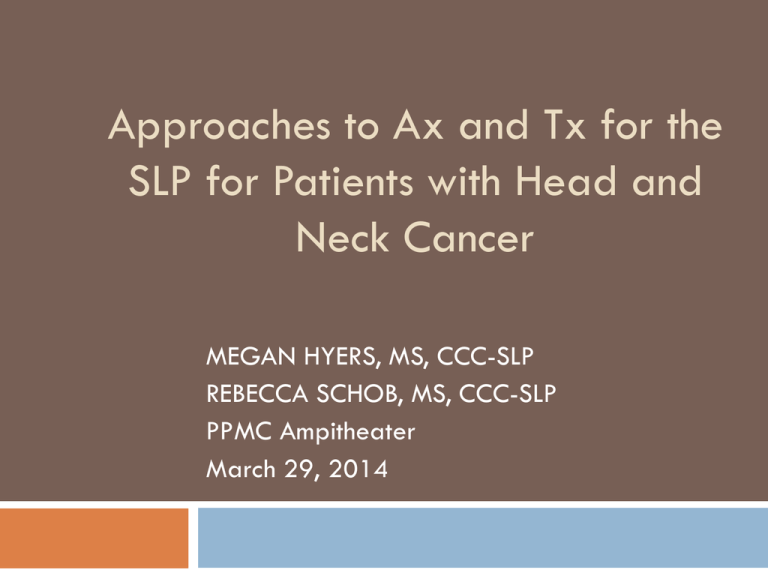
Approaches to Ax and Tx for the
SLP for Patients with Head and
Neck Cancer
MEGAN HYERS, MS, CCC-SLP
REBECCA SCHOB, MS, CCC-SLP
PPMC Ampitheater
March 29, 2014
Dysphagia and XRT
3 phases of Treatment
Before
During
After
“Few other cancers demonstrate the need for anticipatory
Tx and rehab to the magnitude required in the
management of head and neck cancer”
(Myers, Barofsky, and Yates. 1986)
Phase 1: Evaluation before XRT
Clinical eval of speech, voice, swallowing
establish baselines
optimize performance status
implement strategies as needed
determine need for further evaluation
Phase 1: Treatment before XRT
Patient counseling
compare
normal aerodigestive A&P
discuss swallow, voice production, airway management,
trach
review short- and long-term XRT sequelae
Swallowing
Breathing
Trismus
Mucositis
Xerostomia
Intervention for Dysphagia
Order based on muscle effort, ease of application,
ease of learning:
postures
sensory stimulation
swallow maneuvers
diet modification
Pretreatment Dysphagia Protocol
Tongue exercises include passive range of motion and
active assistive range of motion.
Tongue Hold
Effortful Swallow
Laryngeal elevation exercises: pitch glides and
vocalizing /i/ at a high pitch.
Mendelsohn Maneuver and Shaker Exercises
Jaw range of motion exercises: maintain rotary
movements of mastication and decrease the chance of
trismus
Myofascial Release
Start pt working on their scar tissue – ASAP once
staples removed, scabs have fallen off
Mobilizing the scar tissue may help prevent
adhesions, reduced ROM, persistent pain, more
significant effects of lymphedema
Promotes blood flow and blood vessel growth
Most benefit comes just below pain threshold
Use firm pressure, start gently and increase to
deeper massage (see handout)
Desensitization
Trismus
http://oralcancerfoundation.org/dental/trismus.htm
Persistent contraction of
the masticatory muscles
due to hypovascularity
or neural damage.
Prevalence:10%-40%
“Elevator Muscles”
Temporalis
Masseter
Medial Pterygoid
Lateral pterygoid
Trismus
http://oralcancerfoundation.org/dental/trismus.htm
Results in:
Pain:
muscle guarding
Limited oral opening:
Difficulty wearing dentures
Difficulty having dental work performed
Difficulty with intubation for later (elective) surgeries
Dysarthria: decreased speech intelligibility
Dysphagia: difficulty swallowing/eating/drinking
Reduced rotary mastication
Can’t use spoon/fork, take bite of sandwich etc.
Trismus Therapy
Stretching Systems :
Tongue blades (short stretch)
Therabite or Orastretch system (7x/day, 7reps, 7
seconds or 3x/day, 5 reps, 30 seconds)
Trismus stretching systems (cont)
Dynasplint Trismus System (DTS) prolonged stretch
Current study : randomized trials using stretching system for 3-6 months
Start
5-10 minutes, increase to 30-45 mins, 3x/day or
maximum 90 mins/day
Once achieved, then increase tension
Trismus Therapy
Manual Treatments:
Myofascial release
Intra-/extra-oral palpation, stretching, massage
Oral aperture measurements
Female normal bite range is 35-38 mm
Normal for an adult male is 45 to 50 mm
Exercises should be continued for min: 1 year
Contraindications for Trismus
Pain
Poor dentition
Oral aperture of <10mm
Phase 2: during XRT
short-term: get pt through XRT (tolerate and
maintain oral intake)
compensatory
strategies, swallow maneuvers
exercises regimen
pain management
desensitization therapy
saliva substitutes
diet changes
monitor w/subjective and objective evaluators.
Anticipate Acute Effects of XRT
edema
dermatitis and mucositis
mild changes to loss of
taste
xerostomia
odynophagia
erythema
dysgeusia
hypersensitivity
decreased appetite
acute changes in
swallowing occur
vocal deterioration
(hoarseness pitch
changes, vocal fatigue)
later:
stiffness and sensory loss
pain and edema
depression
Mucositis
Inflammation and ulceration of mucosal membranes
From XRT or Chemo
If
Chemo: Usually in 4-10 days
If XRT: 2 weeks, may last 6-8 weeks
Results in
Pain
Dysphagia
Bleeding
Infection
Change
in taste
Decreased appetite and PO intake
How
Development of Oral mucositis
WHO Grading of Oral mucositis
Mucositis
Stage 1 (above) Stage 3 (below)
http://www.caphosol.ca/health-care-professionals
Stage 2 (above) Stage 4 (below)
Px & Tx of Oral Mucositis
http://www.uspharmacist.com/content/s/172/c/29044
pretreatment dental examination
improved dental hygiene
clean
the mouth every 4 hours and at bedtime
more often if the mucositis worsens
use a non-detergent toothpaste
floss between the teeth
use an alcohol-free mouthwash. Use saline or
baking soda mouthwash to soothe & clean the
mouth
Tx of Oral Mucositis
Use artificial saliva, lozenges, gum to lubricate the
mouth.
Suck ice chips
Drink at least 3L/day
Avoid citrus fruits, tomatoes, acidic foods, alcohol,
and hot foods that can aggravate mucositis lesions
Avoid hard, crunchy foods
No smoking
No alcohol
Treatments available
Saliva substitutes
topical and oral medications
Med Oral
Oral Balance (gel)
Mouthkote (lemon based)
Salivart (oil based)
Alcohol-free toothpaste/mouthwash (biotene)
Treatment for Xerostomia
Sip
water, ice chips
Artificial saliva (rinse, spray)
Suck on lozenges/candies (sugar free)
Chew to stimulate saliva production (gum, wax, etc)
Moisten foods
Avoid salty, dry foods, high sugar content foods/drinks
Avoid alcohol or caffeine, also acidic juices
Aloe water, papya
Netti bowl/pot, nasal saline lavage
Overall intervention techniques
Mucositis/Xerostomia:
Oral
hydration : mist bottles, humidifier, etc
Dysgeusa/hypersensitivity
Desensitization
therapy: utensils, taste, texture
Diet modifications
Dysphonia
Vocal
hygiene strategies
Personal amplification (e.g., Chattervox)
Pureed… again?
Need variety!
Protein
powders
Nut butters
Frozen
veggies
Anything!
What can
your blender
handle?
Stress Management
Laughter!!
Pacing and Rest (related to daily tasks and eating)
Guided meditation or relaxation
Breaking down tasks, taking breaks
Mindfulness practices
What’s energy giving (music, pets, walks, bath…)
Basic stretches and mobility
Discuss self-care, talking to someone who can just
listen
The Rule of 10
Logeman, Sisson & Wheeler, 1980
To eat or not to eat?
oral transit time and pharyngeal transit time > 10
seconds, maintain PO but will need non-oral
supplementation
aspiration > 10% , pts eliminate consistency
coughing, choking ? at10% pts stop eating but silent
aspirators continue to eat
aspiration > 10% = non-oral feeding
When to TF?
If PO is good, wait for the problem
if nutrition is poor before XRT, then immediate
weight loss greater than or equal to 5% in less than
or equal to 1 month or greater then or equal to
10% during XRT
Enteral Means of Nutrition
J-tube (jejunostomy) placed between the jejunum and
surface of abdominal wall
G-tube (gastrostomy) placed in the stomach
PEG (percutaneous endoscopic gastrostomy) placed
endoscopically
PFG (percutaneous flurosopic gastostomy) placed
fluoroscopically
Dobhoff/N-G (naso-gastric) tube – place in nose and
passed to esophageus
TPN (total parenteral nutrition) nutrients administered
intravenously-bypass GI system
Why TF?
Optimize tx tolerance
reduce complications related to poor nutrition
improve healing and recovery
increase strength and energy
enhance overall QOL
Temporary!!
Made it!!
Phase 3: After XRT
re-eval speech and swallow when acute Sx have
resolved
one month pt follow-up
re-review effects of fibrosis
swallowing exercises protocol begins and may be
continued for at least one year (5 mins
sessions/10x/day)
evaluate and treat prn
MBSS/VFSS or FEES if needed
Up the Ante for
Dysphagia/Dysarthria Tx
When able, use Biofeedback as much as possible!
FEES
EMG
monitoring for swallow strengthening
Mirror
Tactile feedback
Record and self-evaluate for voice
Vital Stim (Neuromuscular Electrical Stimulation)
If okay’d by physician
No active neoplasm
Know your resources
Prostheodontists or denturist
Palatal
lifts, prosthesis for partial glossectomy…
Behavioral health, MSW
Smoking
cessation
Depression
Nutritionist
Financial assistance
Return
to work
Support Groups
Clergy
Weaning from TFs
Swallow must be safe and efficient
Consider nutritional status pre-XRT
Consider wt loss before/during XRT
Reducing TFs – MUST maintain adequate
nutrition/caloric intake and hydration
Make a plan
Pt’s frequent complaint: lack of appetite
small frequent meals 5-7 meals /day
carry snacks
Goal of eating every hour
consider what else effects appetite:
taste
loss
dysphagia
Constipation, diarrhea
reduced enjoyment
Barriers
Mental
Anxiety about swallowing d/t past pain/difficulty
Effort (cooking time, eating time, swallowing
strategies, calorie counting, etc)
Feelings of isolation, everyone finished before me
at meals, food gets cold, not enjoyable anymore
Most difficult to rehab: one who eats only 1
meal/day, lives alone, etc
In Practice:
The Soft Skills are the most important
Motivational
Interviewing
Listen for the individual’s needs: emotional will likely
come before physical
goals/motivation to eat a type of food, go out to
eat with friends, upcoming holiday meal
ID the support system and get them involved
eat first thing in the morning BEFORE TF so one has
an appetite, normal routine…
Try the scariest foods together in sessions
Lymphedema
Assessment and Treatment for the SLP
Lymphedema
Accumulation of fluid that is relatively high in
protein content
Often found in H&N Cancer following surgery or
XRT
Dx made by physician, not SLP
Why are we looking? Why is it important?
Edema
may exacerbate dysphagia
Negatively impacts QOL
Prevention of lymphedema
Trach tie
should be 1 finger loose as long not moving
can create turniquet effect lump/bump
can induce swelling above trach tie if too tight
if too loose, may cause coughing and pt may be
resistant
Medical Hx
reveals clues re: lymphedema vs other edema
fluctuations in edema
onset of edema vs Tx/trauma
physical characteristics of edema
medical contraindications to Tx?
Physical limitations for implementations?
Post-XRT fibrosis of neck
Timing
how long since surgery, xrt, chemo, or trauma?
Acute post-op edema first 30 days after surgery
CAN INTERVENE DURING this time if SEVERE
typically wait 4-6 wks after surgery or XRT (can
start 2 weeks after surgery)
common onset of lymphedema is 6-8 wks after XRT
completed
lymphedema
Swelling usually starts most distal: lower neck, then
progresses upwards into neck, jowls, etc from scar
up. Over time.
Usually NOT painful
if it is, seek other causes
other causes of edema
hot tub
exercise
allergy
insect bite
drug reactions
thyroid function
etc
Edema characteristics
Soft or Firm?
Persistent or fluctuating? AM to PM, day to day
periods of resolution or exacerbation?
Garden,
car, airplane, heat?
Pitting vs Non-pitting?
If pitting, stage it
Edema characteristics continued
Visual, color?
Should be approximately same as surrounding
tissue
If Dark red tissue
may
be angiosarcoma => lymphatic mets
Physical: feverish, hot, tender
may
be infection or metastasis
Pitting edema
eval based on limbs
Push in gently for 5 seconds,
judge how long it takes for pit to refill
Lymphedema Classifications
International Society of lymphology Lymph rating
scale according to Foldi
NIH lymphedema scale
lymphedema measures
Foldi Stage (0, 1, 2, 3)
MDACC stage (O, 1a, 1b, 2, 3)
Foldi Stages
Stage 0
reported tightness or fullness but no pitting or
significant edema
may fluctuate during the day
Stage I
Pitting edema that is
quickly reversible
No fibrosis or tissue
changes
Improves during the
day and worsens at
night
Swelling may be
temporarily reduced
with elevation
Stage 1
MD Anderson further differentiates:
1a: visible edema you can't pit
1b: visible edema you can pit
Stage II
Not spontaneously reversible
Longer lasting pitting
Fibrosis – scar-like structures within tissues that cause
them to harden
Pressure may result in only slight indentation or none
No severe tissue changes, breakdown etc
Stage III: lymphostatic elephantiasis
Not typically seen in H&N
Severe tissue Changes
Hyperkeratosis
– increased thickness of outer layer of
skin
Papillomatosis – small solid benign tumors
wounds
elephantiasis
Severe fibrosis
Cannot pit with pressure
Facial measurements
facial circumference
submental circumference
horizontal neck circumference
Site of H&N Edema
Face (include eyelids, upper lip, jowl etc)
Submental
Neck
Intra-oral
Suraclavicular Fossa
Unchanged from initial evalutation? PMHx?
left,
right, bilateral, none now
Tactile evaluation: what do you
feel?
Tissue Changes?
Thickness, heaviness
pitting
fibrosis
Lumps & Bumps?
Recurrent
tumor
dermal mets
Cyst
Soft lump, lipoma (fat deposit, soft, always ask)
If ??? Notify MD
Contraindications to Lymphedema
Tx
Infection
Cellulitis
CHF
Cardiac Edema
Renal Failure
Acute DVT
Uncontrolled HTN
Carotid sensitivity
None
Other__________
Physical appearance
Scarring
trap door effect
firm/rigid scar
hypertrophic scar
no effect
Determine
General Functional status (swallow, speech, voice,
cosmesis, respiration, ROM)
Impairments related to edema vs treatment
Support system
Caregivers available to assist?
Home vs outpatient
Cognitive status, new learning ability, commitment?
Treatment
To justify Tx:
Pt requires lymphedema Tx to soften tissues and
prevent fibrosis which may/could/can lead to
dysphagia...
If pt returns
Pt received Tx 'x'# months ago with 'x' diet, now
following 'x' for edema..
pt
feels with edema his/her dysphagia has increased
or
in
AM it’s harder to swallow
Treatment options
Manual Lymphatic Drainage (MLD)
self-MLD
Compression: applies external pressure to promote
improved mobilization of lymph
softens
firm edema and softens skin before MLD
prevents refilling of tissues and promotes continued
drainage via open pathways after MLD
Kinesiotape
Deep breathing for respiratory function/circulation
swallowing routine 4x/day
Who provides the treatment?
In our region: PT’s mostly
YOU can be certified:
Next,
closet training for Eval and Management of H&N
Lymphedema is
July
11-13, 2014
San Francisco
for
Complete Decongestive Therapy(CDT) Certification
July
5-13, 2014
Eugene, OR
Norton School may offer H &N only, IF you contact them and
express interest: www.nortonschool.com
THANK YOU!
“Far and away the best prize that life
offers is the chance to work hard at
work worth doing.”
~Thomas Jefferson (1743-1826)
http://www.lymphnotes.com/article.php/id/208/
http://www.uspharmacist.com/content/s/172/c/29044/
http://www2.mdanderson.org/depts/oncolog/articles/13/8-aug/8-13-1.html
http://www.lymphedemablog.com/2012/05/11/secondary-lymphedema-of-the-head-andneck/

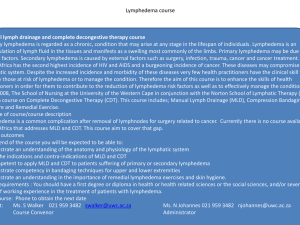
![Dysphagia Webinar, May, 2013[2]](http://s2.studylib.net/store/data/005382560_1-ff5244e89815170fde8b3f907df8b381-300x300.png)
